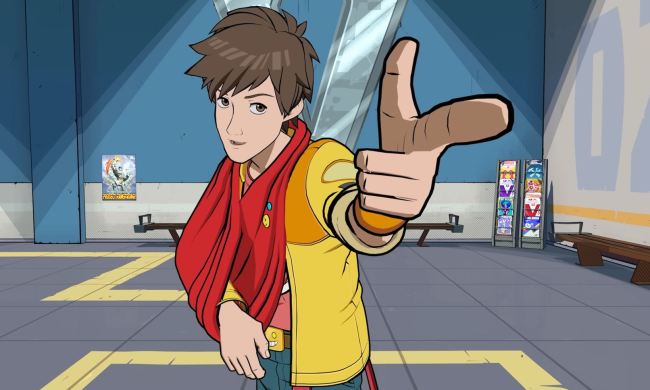“Gauntlet is just as chaotic as its predecessors, but more refined and less haphazard too.”
- Fun, old-fashioned co-op
- Varied character skills
- High replay value
- Riddled with bugs
- No drop-in/drop-out co-op
- Quite brief
Before the Internet (gasp!) people had to actually be in the same room to play video games with one another. It seems hard to believe now, but it’s true. Gauntlet is a relic of that time, but it’s also proof that the past is alive and well.
There’s definitely something to be said for sitting down with a few buddies and four controllers and conquering a game like the good old days, and Gauntlet lets you do that—in one sitting, if you’re inclined. That will be the appeal for many players. But with online matchmaking, four playable characters with extremely varied move sets, multiple difficulties, and a satisfying (if shallow) progression system, Gauntlet could also potentially keep you coming back, despite its relative brevity.
Gauntlet is a relic of a time before the Internet, but it’s also proof that the past is alive and well.
Gauntlet is a frenzied, fast-paced and cutthroat game that can be played solo but is infinitely better with other players (and absolutely best if those other players are friends). The plot, such as it is, is irrelevant, despite some funny dialogue; suffice to say it sends four adventurers questing down a 12-level rabbit hole filled with traps, treasure and a few challenging boss fights. No one element of Gauntlet is going to win any awards by itself, but when all is taken into account it’s a solid old-school multiplayer RPG that puts a few fun twists on a very old formula.
It wouldn’t be Gauntlet without the warrior, wizard, archer, and valkyrie characters to choose from. Each class has several unique moves, including regular and strong attacks, plus even stronger moves that take several seconds to recharge between uses. The valkyrie can throw her shield in an arc, lunge forward with her spear, and block enemies’ attacks; the archer has a powerful sniper shot and a reusable bomb, while the warrior can barrel into enemies or twirl his axe around.
The wizard bears separate mention here. His abilities are drastically different from those of the other three characters, although anyone who played Arrowhead Game Studios’ previous title Magicka will find it familiar. The wizard has access to three magical elements—fire, frost and lightning—that you can combine by tapping a controller’s face buttons (Gauntlet is definitely best with a gamepad) to create a large number of offensive and defensive spells. The cooldown on these varies depending how powerful they are. The wizard is the most versatile class, but also the hardest to master, particularly when it comes to memorizing what all the different button combos do.
You choose your class in the lobby before each session begins, whether you’re creating a game or joining someone else’s. There will only be one of each character during every session, so if you’re the fourth into a lobby you may wind up as a class you’re unfamiliar with or haven’t leveled up, which is fine—you’ll rarely feel underpowered except on higher difficulties.
Each character has its own set of challenges, like killing certain numbers of enemies with specific skills, and unique items that can be equipped, plus “relics” that grant certain effects when used by consuming the potions you find lying around each level. These range from laying traps for enemies to increasing movement speed and even turning enemies into consumable food that restores health (or gets destroyed, if you’re not careful or if you’re in good health and want to screw over a friend—and just like in classic Gauntlet the narrator will always let you know who the culprit who shot the food was).
Gauntlet is a frenzied, fast-paced and cutthroat game that can be played solo but is infinitely better with other players.
With four players in a game, these items can seem scarce, especially with everyone racing to grab every treasure in sight. Gauntlet may be a co-op game, but you’ll never stop competing with your teammates, and your totals—including kills, gold collected and a bonus for finding and wearing a special crown in each area—will be tallied and compared at the end of every level. Thankfully there’s never a shortage of enemies; you might even be impressed by the number that can be on-screen at once. Thankfully, Gauntlet‘s signature rhythm of being ambushed by a huge crowd of foes, taking out their spawners, and mopping up the remnants continues in this iteration. This was never broken, and Arrowhead rightly felt no need to fix it.
It is unfortunate that there are only three groups of four levels, each of which is divided into three separate areas. These span a crypt filled with mummies and other undead, a network of caves inhabited by giant spiders and various beasts, and a hellish forge occupied by cultists and demons. With how much you might want to replay these areas to try out different characters and unlock new items and skills, you may start to wonder why Arrowhead didn’t just make the new Gauntlet procedurally generated, so at least there’d be some variety.
But the environments become more complex as the game progresses, and you’ll appreciate the design of certain levels that double back on themselves and span multiple layers. There are no puzzles to solve per se, but there are plenty of keys to find, blocks to push and cranks to turn. The structure of these levels varies as well, with arena-style endurance brawls and chase levels featuring a pursuant grim reaper interspersed to shake things up.

There are two main things holding Gauntlet back from being really great: a number of hard-to-ignore glitches, and the inability to drop into in-progress co-op sessions. The former issue ranges from tolerable to extremely annoying, especially when these bugs hamper progression. Sometimes a gate will simply fail to open, or one character will inexplicably disappear for the duration of an entire area, unable to respawn, or blocks pushed by non-host players will appear to stay still and kill you if you come near them.
But more than those glitches, the lack of easy drop-in co-op really stings, especially in a game that relies so heavily on multiplayer. You can only hook up with other players before a match begins, and your lineup is locked as soon as you press “start.” If you lose a member halfway through a level—some of which can take more than half an hour to complete—you’re left playing with however many choose to stick around. And there are any number of non-malicious reasons why another player might leave, not least of which is the fact that if your controller gets disconnected from your PC you have to restart the game to get it to recognize it again.
These problems shouldn’t exist in 2014, even in a small game like Gauntlet, but for fans of the series or those looking for some fun and challenging co-op, they’re definitely possible to overlook.
This game was reviewed on PC using a copy provided by the developer.
Highs
- Fun, old-fashioned co-op
- Varied character skills
- High replay value
Lows
- Riddled with bugs
- No drop-in/drop-out co-op
- Quite brief







